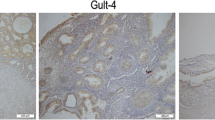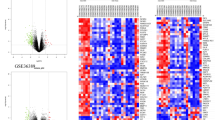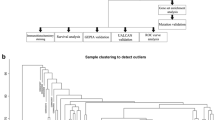Abstract
Purpose
This study aimed to explore the underlying molecular mechanisms of endometrial carcinosarcomas (ECS) and endometrioid endometrial carcinoma (EEC) by bioinformatics analysis.
Methods
Gene expression profile GSE33723 was downloaded from the Gene Expression Omnibus. A total of 15 ECS and 23 EEC samples were used to identify the differentially expressed genes (DEGs) by significance analysis of microarrays. After construction of protein–protein interaction (PPI) network, Gene Ontology (GO) functional and pathway enrichment analyses of DEGs were performed, followed by network module analysis.
Results
A total of 49 DEGs were identified between EEC and ECS samples. In the PPI network, TP53 (tumor protein p53) was selected as the highest degree, hub centrality and betweenness. The top 10 enriched GO terms including regulation of cell death and top 10 significant pathways including cell cycle were selected. After network module analysis, PIK3R1 (phosphoinositide-3-kinase, regulatory subunit 1) and AKT2 (v-akt murine thymoma viral oncogene homolog 2) were selected as the co-expressed genes in the states of ECS while STAT3 (signal transducer and activator of transcription 3) and JAZF (JAZF zinc finger 1) were selected as the co-expressed genes in the states of EEC.
Conclusions
The DEGs, such as TP53, PIK3R1 and AKT2 may be used for targeted diagnosis and treatment of ECS while STAT3 and JAZF1 may be served as a target for EEC.


Similar content being viewed by others
References
D’angelo E, Prat J (2010) Uterine sarcomas: a review. Gynecol Oncol 116:131–139
Barak F, Kalichman L, Gdalevich M et al (2013) The influence of early diagnosis of endometrioid endometrial cancer on disease stage and survival. Arch Gynecol Obstet 288:1361–1364
Mccluggage W (2002) Uterine carcinosarcomas (malignant mixed Mullerian tumors) are metaplastic carcinomas. Int J Gynecol Cancer 12:687–690
Wolfson AH, Brady MF, Rocereto T et al (2007) A gynecologic oncology group randomized phase III trial of whole abdominal irradiation (WAI) vs. cisplatin-ifosfamide and mesna (CIM) as post-surgical therapy in stage I–IV carcinosarcoma (CS) of the uterus. Gynecol Oncol 107:177–185
Menczer J, Levy T, Piura B et al (2005) A comparison between different postoperative treatment modalities of uterine carcinosarcoma. Gynecol Oncol 97:166–170
Bansal N, Yendluri V, Wenham RM (2009) The molecular biology of endometrial cancers and the implications for pathogenesis, classification, and targeted therapies. Cancer Control 16:8
Oda K, Stokoe D, Taketani Y, Mccormick F (2005) High frequency of coexistent mutations of PIK3CA and PTEN genes in endometrial carcinoma. Cancer Res 65:10669–10673
Catasus L, Gallardo A, Cuatrecasas M, Prat J (2009) Concomitant PI3K–AKT and p53 alterations in endometrial carcinomas are associated with poor prognosis. Mod Pathol 22:522–529
Li L, Xu D-B, Zhao X-L, Hao T-Y (2013) Combination analysis of Bub1 and Mad2 expression in endometrial cancer: act as a prognostic factor in endometrial cancer. Arch Gynecol Obstet 288:155–165
Jongen V, Briët J, De Jong R et al (2009) Expression of estrogen receptor-alpha and-beta and progesterone receptor-A and-B in a large cohort of patients with endometrioid endometrial cancer. Gynecol Oncol 112:537–542
Wu W, Slomovitz BM, Celestino J, Chung L, Thornton A, Lu KH (2003) Coordinate expression of Cdc25B and ER-α is frequent in low-grade endometrioid endometrial carcinoma but uncommon in high-grade endometrioid and nonendometrioid carcinomas. Cancer Res 63:6195–6199
Romero-Pérez L, Castilla M, López-García M et al (2013) Molecular events in endometrial carcinosarcomas and the role of high mobility group AT-hook 2 in endometrial carcinogenesis. Hum Pathol 44:244–254
Tusher VG, Tibshirani R, Chu G (2001) Significance analysis of microarrays applied to the ionizing radiation response. Proc Natl Acad Sci USA 98:5116–5121
Tan H, Tian Y, Yang H, Liu G, Nie L (2002) A novel Streptomyces gene, samR, with different effects on differentiation of Streptomyces ansochromogenes and Streptomyces coelicolor. Arch Microbiol 177:274–278
Mcclure R, Balasubramanian D, Sun Y et al (2013) Computational analysis of bacterial RNA-Seq data. Nucleic Acids Res 41:e140
Peri S, Navarro JD, Kristiansen TZ et al (2004) Human protein reference database as a discovery resource for proteomics. Nucleic Acids Res 32:D497–D501
Junker BH, Koschützki D, Schreiber F (2006) Exploration of biological network centralities with CentiBiN. BMC Bioinformatics 7:219
Huang DW, Sherman BT, Lempicki RA (2008) Systematic and integrative analysis of large gene lists using DAVID bioinformatics resources. Nat Protoc 4:44–57
Kanehisa M (2002) The KEGG database. Silico Simul Biol Processes 247:103
Ahmed J, Meinel T, Dunkel M et al (2011) CancerResource: a comprehensive database of cancer-relevant proteins and compound interactions supported by experimental knowledge. Nucleic Acids Res 39:D960–D967
Alibés A, Yankilevich P, Díaz-Uriarte R (2007) IDconverter and IDClight: conversion and annotation of gene and protein IDs. BMC Bioinformatics 8:9
Šubelj L, Bajec M (2011) Unfolding communities in large complex networks: combining defensive and offensive label propagation for core extraction. Phys Rev A 83:036103
Risinger JI, Dent GA, Ignar-Trowbridge D, Mclachlan JA, Tsao MS, Senterman M, Boyd J (1992) p53 gene mutations in human endometrial carcinoma. Mol Carcinog 5:250–253
Koul A, Willén R, Bendahl PO, Nilbert M, Borg (2002) Distinct sets of gene alterations in endometrial carcinoma implicate alternate modes of tumorigenesis. Cancer 94:2369–2379
Sung C, Zheng Y, Quddus M, Kang X, Zhang ZF, Lauchlan S, Zheng W (2000) p53 as a significant prognostic marker in endometrial carcinoma. Int J Gynecol Cancer 10:119–127
Skomedal H, Kristensen GB, Nesland JM, Børresen-Dale AL, Tropé C, Holm R (1999) TP53 alterations in relation to the cell cycle-associated proteins p21, cyclin D1, CDK4, RB, MDM2, and EGFR in cancers of the uterine corpus. J Pathol 187:556–562
Milde-Langosch K, Bamberger A-M, Goemann C, Rössing E, Rieck G, Kelp B, Löning T (2001) Expression of cell-cycle regulatory proteins in endometrial carcinomas: correlations with hormone receptor status and clinicopathologic parameters. J Cancer Res Clin Oncol 127:537–544
Götte M, Greve B, Kelsch R et al (2011) The adult stem cell marker Musashi-1 modulates endometrial carcinoma cell cycle progression and apoptosis via Notch-1 and p21WAF1/CIP1. Int J Cancer 129:2042–2049
Semczuk A, Miturski R, Skomra D, Jakowicki JA (2004) Expression of the cell-cycle regulatory proteins (pRb, cyclin D1, p16INK4A and cdk4) in human endometrial cancer: correlation with clinicopathological features. Arch Gynecol Obstet 269:104–110
Cheung LW, Hennessy BT, Li J et al (2011) High frequency of PIK3R1 and PIK3R2 mutations in endometrial cancer elucidates a novel mechanism for regulation of PTEN protein stability. Cancer Discov 1:170–185
Jiang B-H, Liu L-Z (2008) PI3K/PTEN signaling in tumorigenesis and angiogenesis. Biochim Biophys Acta 1784:150–158
Saegusa M, Hashimura M, Kuwata T, Okayasu I (2009) Requirement of the Akt/β-catenin pathway for uterine carcinosarcoma genesis, modulating E-cadherin expression through the transactivation of Slug. Am J Pathol 174:2107–2115
Slomovitz BM, Coleman RL (2012) The PI3K/AKT/mTOR pathway as a therapeutic target in endometrial cancer. Clin Cancer Res 18:5856–5864
Sianou A, Galyfos G, Moragianni D, Andromidas P, Kaparos G, Baka S, Kouskouni E (2015) The role of microRNAs in the pathogenesis of endometrial cancer: a systematic review. Arch Gynecol Obstet 292:1–12
Chen C, Hsieh F, Lieblein J et al (2007) Stat3 activation in human endometrial and cervical cancers. Br J Cancer 96:591–599
Tang J-Z, Kong X-J, Banerjee A et al (2010) STAT3α is oncogenic for endometrial carcinoma cells and mediates the oncogenic effects of autocrine human growth hormone. Endocrinology 151:4133–4145
Koontz JI, Soreng AL, Nucci M et al (2001) Frequent fusion of the JAZF1 and JJAZ1 genes in endometrial stromal tumors. Proc Natl Acad Sci USA 98:6348–6353
Jakate K, Azimi F, Ali RH et al (2012) Endometrial sarcomas: an immunohistochemical and JAZF1 re-arrangement study in low-grade and undifferentiated tumors. Mod Pathol 26:95–105
Author information
Authors and Affiliations
Corresponding author
Ethics declarations
Conflict of interest
None.
Rights and permissions
About this article
Cite this article
Lin, H., Zhang, M., Yu, H. et al. Analysis of differentially expressed genes between endometrial carcinosarcomas and endometrioid endometrial carcinoma by bioinformatics. Arch Gynecol Obstet 293, 1073–1079 (2016). https://doi.org/10.1007/s00404-015-3880-1
Received:
Accepted:
Published:
Issue Date:
DOI: https://doi.org/10.1007/s00404-015-3880-1




